Since its beginning in 1786,
Emmitsburg has been a self-sufficient town. It had many
small stores, dentists, doctors, garages, hotels and our
own local police force. All the needs of its citizens
were supplied without the need of horse and buggy, or
automobile. Within my memory of over eighty years, the
blacksmith shop, the newspaper, the opera house, the
high school, and the ‘girls’ college have all gone.
And that is called "Progress?"
|
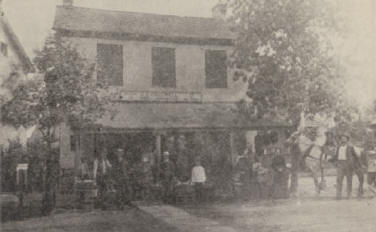
Caldwell's Store |
Starting at the west end of Main
Street on the north side, nothing was more interesting
to the young then Caldwell's store. How exciting to walk
up there with a penny, climb up on the bench in front of
the candy cane and gaze, drool, and get your favorite
‘sweet.’
The pennies were often earned by selling,
at Frailey's
foundry, the horseshoes we found lying in the alleys and streets.
|
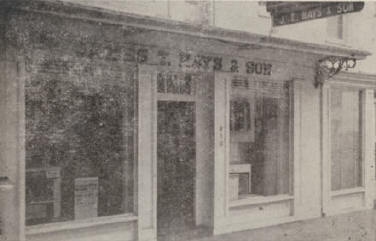
Hays' Tin Shop
|
Duke or Oscar Frailey would give
children $.05 for their findings. Caldwell's store at
324 West Main Street is now a residence and the foundry
is gone too, replaced by a brick residence opposite the
Presbyterian Church.
I might add here that all five of
our town's churches have not disappeared or been torn
down. Praise be!
Between Caldwell’s store and
Frailey's Foundry there were Hays' Tin
Shop and
|
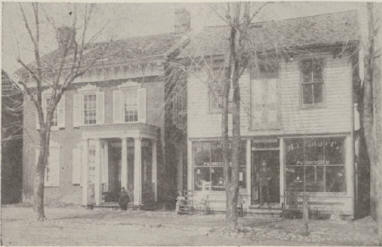
Shuff’s Funeral Home & Furniture Store
|
Shuff’s Funeral Home & Furniture Store. I was sent quite often to Shuff’s for sewing machine needles. At Mrs. May’s house, next to the tin shop where stoves
were also made and sold, we visited quite often; I guess because of the lovely cookies she always had on hand for youngsters. She is well remembered for her kindness to all and
for her family of boys and one girl, who were our early playmates and schoolmates.
|
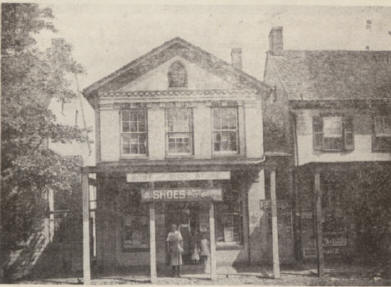
Frank Rove shoe store
|
In the next block Frank Rowe had a
shoe store and, if we weren't watching the smithy at the
anvil, we stopped at Mr. Rowe's and watched intently as
he made or mended shoes. Above his shop was where the
Emmitsburg Chronicle had its start in 1906, under Mr.
Sterling Galt’s editorship.
Next to Mr. Rowe's was a large
grocery and candy business. Guy King had a store there
before it became Matthew's Bottling Works & Store -
our soda pop was made right in town.
|
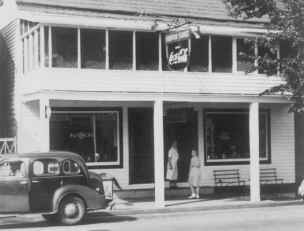
Mathew's Store |
When Guy King had
the business, he hired young boys with little wagons to
peddle bananas over town. My late cousin, born in 1887,
was one of the boys hired. Today it is the shop of a
plumber and the office of a doctor. Between
the King era
and today, F. S. K. Matthew's sold candy, ice cream,
tobacco, etc., there. Each of us in our teens worked
there in the soda fountain making sodas, shakes and
selling ‘tub’ candy at ten cents per pound.
Later
Zurgables hardware ran there, with paint as well as
furniture, then another hardware dealer had it, before
Matthews' heirs sold the property to Reckley's plumbing.
Once there were three doctors as well
as two or three dentists serving the town. Next to
Reckley’s plumbing was Rowe's residence, #300, with
livery stable at the rear where horses and carriages
could be rented. This residence became the home and
office of Dr. Cadle, who worked here many years as a
general practitioner.
In the #200 block the three Felix
sisters ran the telephone office most efficiently and in
a helpful manner. We were even told of calls that came
for us when we happened to be out, if they were from a
distance or important.
House #210, now a funeral home, was
once Cauliflower's store, with wagon parts, etc. and
then it was a residence only. We used to visit there
with a daughter of the house and would fill paper vases
with water and drop them on unsuspecting pedestrians
from the bay window upstairs.
Then came our favorite spot for
"I spy' and "Kick the wicket" - Frizzel’s
Feed, Coal and Grain business. There were lots of coal
and feed bins to hide in for our games and I never saw a
rat there. Then it housed in turn the library, a bake
shop, a notions’ store and a beauty salon. Today the
Laundromat is in one section and the rest of the
building is in small apartments. Behind it, and the
funeral home, is an acre of black top replacing lovely
yards of the past.
West of the
U. C. C. Church - once
German Reformed - was a large ice cream and candy store,
with delicious "sundaes" and an elegant array
of chocolates. Back of the ice cream parlor was a
bowling alley. So many pleasant evenings could be spent
with bowling, refreshments and sometimes singing with
our friends around the tables in the ice cream
"parlor."
Right beyond the church, going east,
there was a shoe repair shop, a bakeshop and now it's a
residence. Have you been to a real butcher shop lately?
There used to be three in town at one time. Now all meat
comes packaged so you can't tell the fat in it or how
succulent it might be. Next to the shoe repair was a
fine butcher shop for many years, with free soup bones
and any and all cuts of meat. Then it became a store on
groceries and meat, but now it is a living quarters for
the descendants.
The very next building, #109, was the
office and home of Dr. Stone, one of the three doctors a
generation or so ago. And by the way, Dr. Stone’s
widow married a Dr. Rig who practiced here. There also
was an office there for one of the dentists. Then the
medical Dr.’s office became a barbershop and a lawyer
from Frederick had some hours per week where the dentist
had been. Today, there's no barbershop or office, only
owners of the home plus several apartments.
To start off the next block there was
a fascinating store - Toker’s. Remember the ‘girly’
magazines, flat fifty cigarettes, and Sunday papers? His
lovely wife fed factory workers at lunch in her kitchen
and I remember strumming on her auto harp which she kept
on the table for us. When the parents died and children
gone elsewhere, the Lutheran Church bought the land and
made lawn and black top alley. I forgot that, before
Toker’s emporium came into existence, a man had
Adelsberger's tin shop selling all sorts of pots, pans
and hardware, too, in the building and her son and his
large family lived in the house next door.
As a young girl, I remember haircuts
in the second barbershop on West Main Street. There were
no beauty parlors so down we trekked for haircuts where
the pharmacy is now. The pharmacy then was where the
Palms Restaurant holds forth. There was a nice foods
fountain parlor in half of the drug store where the
Palms bar is. Some of us waited on customers there, in
the ice cream parlor, when we were teenagers.
On the North West ‘square’
corner, the Annon-Horner Bank was thriving in the
1890's, with A. A. Horner's residence above. Then the
Green Parrot Tea shop opened there, the second place it’s
been. It was such a fine restaurant it needed the large
"bank" building. Now the V.F.W. owns it and
has its bar, meeting room and lounge, with the Auxiliary
upstairs.
The Green Parrot built it's own brand
new place at East Main. The new owners rented the 3rd
floor for a while. Our only veterinarian, Dr. A. A.
Martin, in the early 20th century lived above the Annon-Horner
Bank. On the corner of West Main Street and North Seton
Avenue there has always been a store of some sorts;
clothing stores, drug store - Dr. Treiber's, a great
place to hang out for the high school and college
youths. They all flourished for many years.
Doc
Treiber's wife had a Notion’s store in part of the
building. I remember her green visor she wore in the
store. I guess her eyes were failing. In the back of the
building many years ago, there was a small beauty salon.
Now the building is a drug store with no pharmacist but
only across the counter drugs, cards, gifts and Fire
Academy T-Shirts and souvenirs.
Across the old "Gettysburg
Street" stood a bicycle shop in the first corner of
the large residence of Annon Brothers
house, built for
them. It has a pair of curving identical steps like a
mirror reflection. The house part is nice apartments
now. Before the Annon House was built in 1868. It was
another brick dwelling used by the early Catholics for
services. The bicycle shop later housed Houcks’
clothing store and then the Green Parrot for a time, and
now is a liquor store. A beauty shop is in the other
half of the 1st floor. I have no recollection of what
ran where the beauty shop is now - before Houcks store
which used the whole first floor.
Then the K. of C. building, which was
once a hotel, then with the K. of C. in constant
ownership, it was used by the Mother Seton Guild before
her canonization, after Houck’s store had been there
for a while. Today it's an excellent place to eat and
the K. of C. meeting rooms and bar are above.
East Main Street had far fewer
businesses then west - maybe because of the fire in
1863. But below the center or "Square" as it
is called, on the north side, after a residence, was a
small shop where a retired Saint Joseph’s College
professor had a little gift shop. Now it's a regular
barbershop, almost the type "for men only."
Next, going east, was a lovely little teashop for a
short while. Now it's Humerick's Insurance. On the
property below the house next in line, there's a very
small building where "Fettle" was sold. Mr.
Galt of Chronicle fame was the owner of
"Fettle" business. It was a homeopathic liquid
for stomach problems, very bitter. Later on, that little
building also housed the library in it's
"hard-up" days.
In the 100 block coming next
was the third town doctor of my memory - Dr. Freeman. At
the end of that block was a flourishing butcher
business, Quincy Shoemaker, owner. He peddled meat in
Thurmont as well as in his store and he gave the boys
who followed his truck hot dogs - raw! Roy Bollinger
carried on the business. Today the building houses
"Radio Shack" and a TV business. No more meat!
In the next block was our third
medical doctor at that time, Dr. Browner. His office and
home is now a residence. No more in that block except an
old house with siding now covering it, but a brick
spring house in the rear which shows its the age.
In the next block, #301, stands an
old stone factory, covered now with siding and windows
gone. It was once a sewing factory and, some say, an
opera house. Today it is the Masonic home. Then on down
at the end of the block, Mrs. McNair built the
"Green Parrot" - its third home. It thrived
there as one of the famous restaurants of this area and
beyond. It remained there until it closed due to ill
health of the owner. Now it is a garden and
farm-implement supply store.
Below this block there once were no
businesses but now there is a garage, repair shop, tire
store and residence. Across Flat Run, where a large farm
was sacrificed, there stands the only real grocery store
for the area. Pity those who can't drive!
Coming westward on the south side,
the first business was Gillelan’s Cash & Carry
House, which became Boyle’s store, which served us so
well for many years. It's now a deli, video store and
artist studio. Mark Harting had a fascinating match
repair shop and the second floor above those stores long
ago. He also "did" bicycles. I still have the
watch my mother bought second hand at Harting's place.
That was in 1926. I treasure it because in days of dire
poverty she sacrificed much to get my graduation gift,
and the watch still works. Now the upper two floors are
apartments. No more businesses in my memory until we got
toward the "square." That side of the street
on right was in front of the Guthrie & Beam livery, the Antique Hall parking lot would be the site
of the livery stable.
So we get to the bank and town office
section. For many years a grocery store thrived where
the bank drive-in road and the bank’s extension are
built. First, there was Kerrigan's grocery, then A &
P store, then Bill Rowe's store. Somewhere along the
line was a shoe repair shop, and also Keilholtz's
restaurant. Keilholtz moved to the site of Palm
restaurant and then to the site of the Carriage
House restaurant, before going out of business.
Where the bank stands there was also
a lovely archway to a brick residence. Then comes the
Slagle Hotel, or Western or Eagle, whatever year it was
mentioned it had different names and possibly different
owners. Today, it houses apartments and a video shop
with pizza shop on the ground floor or basement. Once
there was a five and dime store in the basement, a
barbershop and a fast lunch place.
Now let's consider the thriving north
side of West Main Street. On the ‘square’ corner was
the Post Office for many years, in what was called the
Zimmerman building. The building was built on the site
of the first log house in town. The Post Office in the
past had three female post mistresses -- Mrs. Foremen,
wife of one of our dentist, Mrs. Combo, and Miss Grace
Rove. Women's Lib started earlier than we realize,
didn't it?
Next to the Post Office one of the
Zimmermann's had an excellent furniture store in what is
now Ott's Crab House. After the demise of the furniture
store there followed two or three different renters
running restaurants or tearooms. We called them tearooms
if they were a little fancier with real cloths on tables
and fancier foods. The large building, housing Ott's Pub
today, was Isaac Annon's store, then Acme store,
Charlie
Harner's store, and in other parts of the ground floor
there was a beauty shop, then a hardware store and the
library. Today all of the first floor is used by the
"Pub." Apartments were above and are still
there.
The Fire Company has purchased the
rest of that first block. Bern Welty’s house, where
one of the early town choral societies met, is now
rented out by the Fire Company. Next to that was Harry
Rowe’s little store. We enjoyed stopping in that tiny
spot to watch him smoking the last bit of his cigar,
holding it by sticking a toothpick through the last inch
of it. Before the fire company tore that building down
for their expansion, there was another dentist and his
office there. He now resides in
Emmit Gardens. The main
and oldest building housing the Fire Company was the
original Chronicle building and when the school was
being built in the 1920'a we attended grade school there
waiting for the new school's completion. The Mesons used
to meet above the Fire Company. The Chronicle moved to
South Seton Avenue using the old school house in 1922.
The Chronicle owned the building from 1908-1922.
The Fire Company also bought the
large brick house west of the Chronicle building. It was
once the Presbyterian parsonage with lovely large rooms. Now
there are numerous small rooms and quite a few
apartments. The building is Flemish bond patterned brick
with a water table in the brick works; water table is
thought to be efficient in keeping rain from cellars.
This brick building is thought to be the third brick
building built in Emmitsburg. The rear gardens are now
more blacktop.
The first house in the 100 block used
to be the home of Levin Matter, tanner, he added onto
the already standing structure in 1798 and, in 1810, the
right end to the original built in 1795. He had a large
tanning business, which extended almost to the present
day community center. In later years a Nation’s store
was in the east end of the building when Ruth Gillelan
moved next to her residence from up West Main St.
Two doors up was a tunnel-like
entrance to Mike Hoke's excellent restaurant famous for
oysters and also it served beer. That little restaurant
is today a small residence back from the street. Up the
same block, our theater of years past came after the end
of Helman's large general merchandise store. Mr. Helman
was the author of the 1906 "History of
Emmitsburg." East of the theater was a very small
building, now gone completely, where Dr. Foreman had a
dentist business for a short time. His wife had already
entered the picture as one of the three female
postmistresses.
Then abutting that building ran the home
of Dr. Jamison. He served Emmitsburg along with Dr.
Stone, Dr. Riggs, Dr. Freeman and Dr. Browner. Dr.
Jamison is remembered for having collided in his
carriage many times with our center square
fountain. It
is thought drunkenness affected his driving, but maybe
he was too tired. Remember they all made house calls
then. Today his large home and office combined are three
or four apartments.
The first house, #201 in the next
block, was of log, then cased in brick and now covered
with white siding. An Eyster had a jewelry and
watchmaker’s shop and following, the public library
was there about 75 years ago. Also the Masonic Lodge met
upstairs. Now it is a single-family residence with a
garden in the rear. Next door is a long building serving
three families. The largest part contained John Gelwick’s
large Hardware Store. I remember diamond shaped glass
windows up above the second floor -- they spelled ‘Gelwicks’.
There were eight of them under the roof edge with
pointed capital letters, very attractive. Now siding has
caused their disappearance. The three parts of that
section are all individual homes, although the largest
section’s owner rents rooms.
Right next door at #211 is a very
small apartment section where the former Hall Eyster's
Jewelry store stood. It’s a very tiny living space
now. Number 227, the former Loughhead's Tavern in the
early 1800's, contains the other water table in the
brick. I know for a fact that there has never been water
in the cellar of that house. In the addition, built west
of #227 onto the original house, there was a store for
various commodities owned by Joshua Motter and one other
before him. It was built on in 1838, with bowling in the
rear, probably lawn bowling. Then, in my memory, Miss
Ruth Gillelan had a ‘utility' shop --notions and dry
goods, mostly materials and other things related to
sewing. When it closed, the storefront was completely
changed and it is a fine residence.
#303 and #305 was the Stoke’s
residence with a harness shop in #303. He was also
Justice of the Peace and when the police brought
offenders we would sneak around back and watch justice
being served amid the harness. His wife had a pedal
organ and she welcomed the youngsters to come and play
it and her cookies were generously shared with us. There
was a hitching bar outside and we all learned to chin
and 'skin the cat’ there. Then butting right next to
it was the third butcher shop in town.
Then Morris
Gillelan ran it and lived next door. After his ownership
come Harry Frushour, a teacher who wanted to try his
hand at the butcher business. Now after many changes it
is a private residence. Next door to it, in the former
home of Morris Gillelan, there was an antique business
for a while. Number 317, beyond the Methodist Church,
for a while, was a men’s clothing store and has now
become a residence.
On the corner of this block, where
there are numerous apartments owned by Joe Welty, there
was the famous grocery store carried on by Joe Hoke, Mr.
Sellers, and finally Mr. Clarence Frailey. That Joe Hoke
was a distant cousin of the Mike Hoke who ran a hotel on
North Seton Avenue and a tavern on West Main. Mike had a
son, Joe Hoke who was one of our town fathers in the
past. Mr. Frailey had a fine store and is long
remembered as the "Santa Claus of the Sunday
Schools." He donated all the oranges and candy
every year at Christmas to all the churches. At
Christmas time we all visited the second floor at the
store to see all the things we wished for at Christmas,
but the clerk repeatedly was saying "boys don't
touch the toys." I don't know whether we girls got
a rhyming admonition.
Across the alley in the back of
Albert Patterson’s residence we trekked up to Basil
Gilson’s shop where milk and cream were sold. In the
bygone years we carried our own containers to be filled,
bottles arrived later. After the "milk" shop
was no more, Mr. Patterson’s daughter, Mrs. Ruth
Peppler, for a short time had a yarn and knitting
supplies store. In the back garage along the alley, Mr.
Warren Kugler refinished furniture for quite some time.
Today it is all apartments.
Next door where Joke Hake lived, his
daughter, Miss Lottie Hoke, had a lovely tearoom for a
short time after being a teacher in our local high
school in the 1920's. That building is two residences
today. Where an apartment house stands at #501, there
once was a thriving granite works. It was called Hoke
and Rove, or Rider & Smith, named accordingly by
those who worked. They made tombstones and other granite
necessities. It is thought prior to the granite works,
Nathaniel Rowe was apprenticed to John Armstrong and
learned to make guns there. Near the end of this block
was Wagman’s garage, followed by Green's bakery and
now a small house.
The large building at the
intersection was a fine hotel. It had many different
names. People spent summers there to get away from the
heat of the cities. Today it is completely apartments
except for a realtor office and surveying headquarters
of the owners.
Going north from the square - now
called North Seton Avenue rather than Gettysburg Street,
there was Ashbaugh's grocery
store. Now replaced by the
"new' Irishtown Road which goes out to Poplar
Ridge, our favorite place for a walk and for gathering
wild flowers in the spring and nuts in the fall.
At #211 there was Mike Hoke’s
Hotel, so-called, but really 'Smith’s’. Mike Hoke
had married a Smith daughter and chauvinism took over.
Today that building is apartments and a beauty salon.
Right below this building there was a third barber shop,
Mr. Troxell's. Each street took care of necessities for
those who lived nearby, with grocers, barbers, etc. The
American Legion Building, close to the square, was first
a hosiery factory, then clothing. Once, the health
clinic was held in the basement. Now the Legion uses the
whole property.
On South Seton Ave., formerly
Frederick Street, or just "The Pike", as we
called it, there were few houses prior to 1870. For a
while at #101 the Opera House functioned for
presentations, meetings, etc. Then Mike Thompson, Mayor,
baseball magnate, built his house on the land which a
dentist has turned into his office. By the way, he's the
only dentist practicing here now, and we once had two or
more here at the same time.
Below that lot stands the
Chronicle
Press. It was the second school built in Emmitsburg. The
first is now the residence of Kuglar's up beyond the
hotel at the end of West Main Street. This school on ‘The
Pike’ was-for all grades. In 1922 the building housed
the Chronicle publishing house, and today above the
Chronicle Press - which does printing only - there are
apartments. On down the street our only resident lawyer
resided, Mr. Vincent Sebold.
These businesses were on the east
side and now on the west there was Zimmermann &
Maxwell’s feed and grain business. This was followed
by numerous restaurants. The ‘Carriage House Inn’ is
there now plus a flower shop and a beauty parlor in the
same building. Bernard Welty and Joe Wivell had a
foundry and blacksmith shop for many years where Paul
has his ‘Pit Store’ selling liquor now, with
apartments above. The building originally was our only
motel. It didn't ‘go’ and now apartments are above
the liquor store. The blacksmith did fine ironwork as
well as taking care of the horses and farm equipment.
The present Sperry building, other than being a Ford
garage and salesroom for many years, was the sight of
Dukehart's Carriage House, from the days when carriages
and horses were "it".
On the Provincial House property,
formerly the sight of Emmitsburg Railroad, was Fox’s
garage and service station and the St. Joseph's College
and Academy for almost 175 years. There now is the large
basilica, Villa St. Michael’s, for aged nuns and St.
Elizabeth Ann Seton Shrine. Most of the College property
was sold to the government for the Fire Academy and
federal emergency training of firemen from all over the
country. The railroad, which used to bring girls to the
college via Rocky Ridge and also the school children to
Emmitsburg school, has completely disappeared.
The old high school across from St.
Joseph’s is now a community center; police, health
clinic, library, Scouts, Art classes all use this
building as well as the Senior Citizens. It once housed
all grades. Today we have only grades K through six.
Up toward the town square was what we
once called the ‘Upper’ garage and also Mort’s
garage (a lovely brick buildings). John Hollinger owns
the upper garage. It is empty except for a small
apartment in the front. The lovely 'Mort' or 'Wagerman'
(since he had a garage there also) building was torn
down to make parking for the Ott’s Apartment.
In conclusion, I must say that there
have been so many changes, so many losses of the small
businesses, I wonder are these changes all good, or
would we like a little more community self-sufficiency?
I'm sure many readers can tell me
what my 80 years of living here have forgotten, but
maybe you'll enjoy the reminiscing anyway.
Have your own memories of people in
Emmitsburg?
If so, send them to us at history@emmitsburg.net